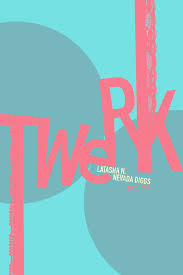Multilingual sounds
Coca-Cola's "It's Beautiful" vs. LaTasha N. Nevada Diggs's TwERK

Is multilingual poetry any different from other representations of multilingualism in contemporary culture? In my previously two commentaries, I've looked at some of the things that multilingual poetry does differently than other kinds of poetry. But what does it do differently from other cultural forms that are also multilingual?
One recent example of a multilingual cultural text is Coca-Cola's 2014 Super Bowl commercial "It's Beautiful," which was also shown during the Sochi Olympic Games. This ad touched a nerve because it features eight tween girls singing "America the Beautiful" — but they do so in, Spanish, Tagalog, Mandarin, Hebrew, Keres, Senegalese French, and Arabic as well as English (quelle horreur!). Beginning in English with a shot of a cowboy on a white horse, the ad includes diaphanously lit outdoor scenes, wholesome images of kids in a movie theater, surfers bobbing on the waves, break-dancers, a family on a roadtrip, a brightly lit Chinatown. Representations of urban modernity and rural tradition are seamlessly interwoven, and all differences are overcome through the shared melody of the girls' multilingual hymn.
My take on this ad is that these young girls "too, sing America" — a weird kind of nod to Langston Hughes. Unlike Hughes's "I, too," which offers an impassioned critique of anti-Black racism, Coca-Cola's ad doesn't challenge anything (of course not!). Instead, its celebration of America glosses over histories of race-based exclusion and the present-day racial and gendered inequalities that the singers might face. In this way, Coca-Cola's ad is pretty typical of many cultural representations of multilingualism: it represents a benevolent, exciting, and non-threatening expansion of the national body — in the words of one critic, it's "all of the diversity and none of the discrimination."
In the realm of poetry, however, multilingualism usually does something different. Without a familiar melody to drown out and smooth over unfamiliar words, we are left to grapple with long histories of cultural exchange and confrontation.
Take, for example, the work of LaTasha N. Nevada Diggs, who weaves densely textured poems from the languages of her local communities and everyday life. In interviews Diggs explains that her upbringing in Harlem brought her into contact with Puerto Rican, Dominican, and Haitian schoolmates, Chinese business owners, and later with West African French-speaking communities and a Bangladeshi diaspora. Accordingly, her poems are written in a dizzying array of languages including English, Spanish, Japanese, Hindi, Maori, Hawai'ian, Samoan, Malay, Swahili, Quechua, Yoruba, Portuguese, Chamorro, Barbadian dialect, Cherokee, Tagalog, and Papiamentu.
TwERK (2013), her first book, orchestrates a virtual-world mash-up of racialized and racist figures from across the globe: the first sequence of poems, "anime," includes a dialogue between the Japanese animé characters Jynx (from Pokémon) and Mr. Popo (from Dragonball manga, and here called "Mista," evoking closer-to-home histories of racialization). Jynx and Mr. Popo have both been widely criticized as contemporary examples of racist caricature, and both were even altered for North American audiences in order to minimize their racist associations: Jynx's skin tone was changed from black to purple, and Mr. Popo's was changed from black to blue. His exaggerated red lips were also shaded in completely.
Diggs's poems take up these transformations, and the two characters address one another in paired poems, "mista popo hollas @ jynx" and "who you callin' a jynx?" The first begins, "In 2004, Viz began to downside Mr. Popo's large lips digitally," and alternates between a narrating speaker and Mista Popo's "croon[ing]" to Jynx: "Mista Popo want that hibiscus round your neck. // Mount me with your mammy tie-dyed kimonos // Go-go ganguro manga mamasita izza to my dizza" (3, 4). Mista Popo's humorously lascivious come-ons evoke the cultural mythos around Black male sexuality, but his comments also suggest alternative sources for Jynx's appearance — her straight blond hair, wide lips, and black skin have also been compared to the ganguro girl culture, a Japanese fashion trend in which young women wear a dark tan and deliberately artificial contrasting makeup. So where exactly do these racialized caricatures come from?
Diggs tracks the evolving images of Jynx and Mr. Popo and the exaggerated romantic plot she establishes between them. As the speaker in the first poem states, "Mista Popo was determined to prevent Kami [whom he serves] from tappin Jynx's ass before him" (3), but Jynx "ain't feeling [his] vibe easy breezy / ... // Mista Popo, mista Tom, // you queasy" (18). The poems revolve around the idea of blackness as property through the contested intellectual property of the animé creators, through Mr. Popo's status as Kami's servant, and through Mista Popo's attempt to make Jynx "his." But Jynx's refrain "ya can't handle it!" disrupts this idea of ownership and reinscribes the meaning of the characters' changing skin colors. Jynx declares herself a "half-breed" ("Watashi wa zasshu") and suggests that her "black/purple flesh" is the valuable result of "cross-polination." If this element of hybridity is what allows Jynx and Mr. Popo's images "mass circulation" in North America, Diggs also suggests that it is the "mass circulation" of racist caricatures that gives rise to Jynx's "cross-polinat[ed]" image in the first place.
In Diggs's poems, rhythm pulls us through any number of languages, which we encounter like clusters of street signs. But unlike the multilingual song in "It's Beautiful," rhythm doesn't hide complication or provide a facile feeling of familiarity and comfort. Instead, in Diggs's poetry — as in so much multilingual work — it is precisely through the sonic qualities of rhythm and rhyme that we're forced to confront difference as difference. And what's important about Diggs's poetry is that although the confrontation is always a lot of things, it's never merely beautiful.
Languages